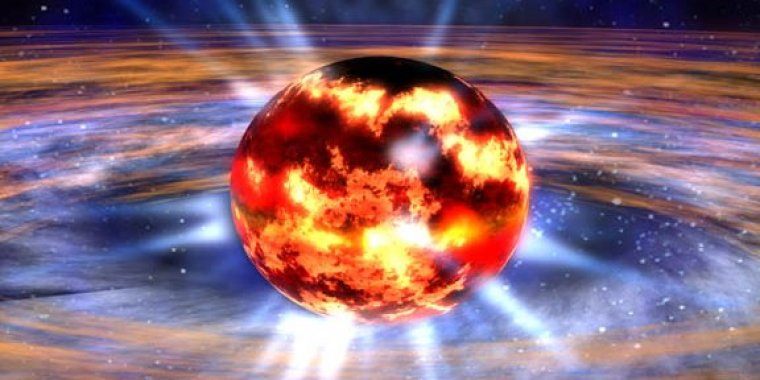| News / Science News |
Element creation in the lab deepens understanding of neutron stars
Led by nuclear astrophysicist Kelly Chipps of the Department of Energy’s Oak Ridge National Laboratory, scientists working in the lab have produced a signature nuclear reaction that occurs on the surface of a neutron star gobbling mass from a companion star. Their achievement improves understanding of stellar processes generating diverse nuclear isotopes.

Neutron star. Photo: NASA
“Neutron stars are really fascinating from the points of view of both nuclear physics and astrophysics,” said Chipps, who led the study.
“A deeper understanding of their dynamics may help reveal the cosmic recipes of elements in everything from people to planets.”
Chipps heads the Jet Experiments in Nuclear Structure and Astrophysics, or JENSA. The team uses a unique gas jet target system, which produces the world’s highest-density helium jet for accelerator experiments, to understand nuclear reactions that proceed with the same physics on Earth as in outer space.
The process of nucleosynthesis creates new atomic nuclei. One element can turn into another when protons or neutrons are captured, exchanged or expelled.
A neutron star has an immense gravitational pull that can capture hydrogen and helium from a nearby star. The material amasses on the neutron star surface until it ignites in repeated explosions that create new chemical elements.
Many nuclear reactions powering the explosions remain unstudied. Now, JENSA collaborators have produced one of these signature nuclear reactions in a lab at Michigan State University. It directly constrains the theoretical model typically used to predict element formation and improves understanding of the stellar dynamics that generate isotopes.
For the current experiment, the scientists struck a target of alpha particles (helium-4 nuclei) with a beam of argon-34. (The number after an isotope indicates its total number of protons and neutrons.)
The result of that fusion produced calcium-38 nuclei, which have 20 protons and 18 neutrons. Because those nuclei were excited, they ejected protons and ended up as potassium-37 nuclei.
High-resolution charged-particle detectors surrounding the gas jet precisely measured energies and angles of the proton reaction products.
Accounting for the conservation of energy and momentum, the physicists back-calculated to discover the dynamics of the reaction.
“Not only do we know how many reactions occurred, but also we know the specific energy that the final potassium-37nucleus ended up in, which is one of the components predicted by the theoretical model,” Chipps said.
The lab experiment improves understanding of nuclear reactions that occur when material falls onto the surface of an important subset of neutron stars.
These stars are born when a massive star runs out of fuel and collapses into a sphere about as wide as a city such as Atlanta, Georgia. Then gravity squeezes fundamental particles as close together as they can get, creating the densest matter we can directly observe.
One teaspoon of neutron star would weigh as much as a mountain. Neutron-packed stars rotate faster than blender blades and make the universe’s strongest magnets.
They have solid crusts surrounding liquid cores containing material shaped like spaghetti or lasagna noodles, earning them the nickname “nuclear pasta.”
“Because neutron stars are so weird, they are a useful naturally occurring laboratory to test how neutron matter behaves under extreme conditions,” Chipps said.
Achieving that understanding takes teamwork. Astronomers observe the star and collect data. Theoreticians try to understand physics inside the star. Nuclear physicists measure nuclear reactions in the lab and test them against models and simulations. That analysis reduces large uncertainties resulting from a dearth of experimental data.
“When you put all of those things together, you really start to understand what’s happening,” Chipps said.
“Because the neutron star is superdense, its huge gravity can pull hydrogen and helium over from a companion star. As this material falls to the surface, the density and temperature grow so high that a thermonuclear explosion can occur that can propagate across the surface,” Chipps said.
Thermonuclear runaway transforms nuclei into heavier elements. “The reaction sequence can produce dozens of elements.”
Surface explosions do not destroy the neutron star, which goes right back to what it was doing before: feeding off its companion and exploding.
Repeated explosions pull crust material into the mix, creating a bizarre composition in which heavy elements formed during previous explosions react with lightweight hydrogen and helium.
Theoretical models predict which elements form. Scientists typically analyze the reaction that the JENSA team measured using a statistical theoretical model called the Hauser-Feshbach formalism, which assumes that a continuum of excited energy levels of a nucleus can participate in a reaction.
Other models instead assume that only a single energy level participates.
“We’re testing the transition between the statistical model being valid or invalid,” Chipps said. “We want to understand where that transition happens. Because Hauser-Feshbach is a statistical formalism — it relies on having a large number of energy levels so effects over each individual level are averaged out — we’re looking for where that assumption starts to break down. For nuclei like magnesium-22 and argon-34, there’s an expectation that the nucleus doesn’t have enough levels for this averaging approach to be valid. We wanted to test that.”
A question remained about whether the statistical model was valid for such reactions taking place in stars rather than earthly laboratories.
“Our result has shown that the statistical model is valid for this particular reaction, and that removes a tremendous uncertainty from our understanding of neutron stars,” Chipps said.
“It means that we now have a better grasp of how those nuclear reactions are proceeding.” (Oak Ridge National Laboratory)
YOU MAY ALSO LIKE





